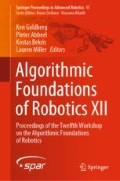Abstract
Humans often change the geometry of flexible objects during manipulation so that the goal is easier to accomplish with either simple motions or simple controls. This paper explores how to change the geometry of a knot to allow simpler tying or untying. The paper presents algorithms that modify the knot configuration to allow the knot to be arranged into the correct topological structure or untangled by moving the tip of the string along a straight line, with only a few re-grasps. The paper also presents proof-of-concept physical experiments in which robot arms arrange and untangle several knots.
Access this chapter
Tax calculation will be finalised at checkout
Purchases are for personal use only
Preview
Unable to display preview. Download preview PDF.
References
C.C. Adams. The Knot Book: An Elementary Introduction to the Mathematical Theory of Knots. American Mathematical Society, 2004.
J. W. Alexander. Topological invariants of knots and links. Trans. Amer. Math. Soc., 20:275–306, 1923.
Ted Ashton, Jason Cantarella, Michael Piatek, and Eric Rawdon. Knot tightening by constrained gradient descent. Experimental Mathematics, 20(1):57–90, 2011.
Stephen W. Attaway. The mechanics of friction in rope rescue. International Technical Rescue Symposium, 1999.
Devin J. Balkcom, Jeffrey C. Trinkle, and E. J. Gottlieb. Computing wrench cones for planar contact tasks. In ICRA, pages 869–875. IEEE, 2002.
J. Baranska, S. Przybyl, and P. Pieranski. Curvature and torsion of the tight closed trefoil knot. The European Physical Journal B - Condensed Matter and Complex Systems, 66(4):547–556, 2008.
Matthew P. Bell. Flexible Object Manipulation. Technical Report TR2010-663, Dartmouth College, Computer Science, Hanover, NH, February 2010.
Matthew P. Bell,WeifuWang (co-first author), Jordan Kunzika, and Devin Balkcom. Knottying with four-piece fixtures. International Journal of Robotics Research (IJRR), vol 33, no. 11:1481–1489, Sep, 2014.
Stephen Berard, Kevin Egan, and Jeffrey C. Trinkle. Contact modes and complementary cones. In ICRA, pages 5280–5286, 2004.
G. Burde. Knoten. Jahrbuch Ueberblicke Mathematik, pages 131–147, 1978.
Erik D. Demaine, Martin L. Demaine, Andrea Hawksley, Hiro Ito, Po-Ru Loh, Shelly Manber, and Omari Stephens. Making polygons by simple folds and one straight cut. In Revised Papers from the China-Japan Joint Conference on Computational Geometry, Graphs and Applications (CGGA 2010), Lecture Notes in Computer Science, pages 27–43, Dalian, China, November 3–6 2010.
John E. Hopcroft, Joseph K. Kearney, and Dean B. Krafft. A case study of flexible object manipulation. International Journal of Robotic Research, 10(1):41–50, 1991.
H. Inoue and M. Inaba. Hand-eye coordination in rope handling. Robotics Research: The first International Symposium, pages 163–174, 1985.
H Kang and J.T. Wen. Robotic knot tying in minimally invasive surgeries. In IEEE/RSJ International Conference on Intelligent Robots and Systems (IROS), 2002.
Hyosig Kang and John T.Wen. Endobot: a robotic assistant in minimally invasive surgeries. In Proc. IEEE International Conference on Robotics and Automation, volume 2, pages 2031–2036, 2001.
Hyosig Kang and J.T. Wen. Robotic assistants aid surgeons during minimally invasive procedures. Engineering in Medicine and Biology Magazine, IEEE, 20(1):94–104, Jan 2001.
L.H. Kauffman. Knots and Physics. K & E series on knots and everything.World Scientific, 1991.
Makoto Kudo, Yasuo Nasu, Kazuhisa Mitobe, and Branislav Borovac. Multi-arm robot control system for manipulation of flexible materials in sewing operation. Mechatronics, 10(3):371 – 402, 2000.
W.B.R. Lickorish. An Introduction to Knot Theory. Graduate Texts in Mathematics. Springer New York, 1997.
Charles Livingston. Knot theory. The carus mathematical monographs, Volume Twenty Four. The mathematical Association of America, Washington D.C., 1993.
Wen Hao Lui and Ashutosh Saxena. Tangled: Learning to untangle ropes with RGB-D perception. In 2013 IEEE/RSJ International Conference on Intelligent Robots and Systems, Tokyo, Japan, November 3-7, 2013, pages 837–844, 2013.
J.H.Maddocks M. Carlen, B. Laurie and J. Smutny. Biarcs, global radius of curvature, and the computation of ideal knot shapes. Physical and numerical models in knot theory, 36 of Ser. Knots Everything:75–108, 2005.
Matthew T. Mason. Mechanics of Robotic Manipulation. MIT Press, Cambridge, MA, August 2001.
Eric J. Rawdon. Approximating the thickness of a knot. Ideal knots, 19 of Ser. Knots Everything:143–150, 1998.
Kurt Reidemeister. Elementare begrndung der knotentheorie. Abhandlungen aus dem Mathematischen Seminar der Universitt Hamburg, 5(1):24–32, 1927.
D. Rolfsen. Knots and Links. AMS/Chelsea Publication Series. AMS Chelsea Pub., 1976.
Mitul Saha and Pekka Isto. Motion planning for robotic manipulation of deformable linear objects. In Proc. IEEE International Conference on Robotics and Automation, pages 2478–2484, May 2006.
Mitul Saha and Pekka Isto. Manipulation planning for deformable linear objects. IEEE Transaction on Robotics, 23(6):1141–1150, December 2007.
Mitul Saha, Pekka Isto, and J.-C. Latombe. Motion planning for robotic knot tying. In Proc. International Symposium on Experimental Robotics, July 2006.
Zoe McCarthy TimothyWBretl. Quasi-static manipulation of a Kirchhoff elastic rod based on a geometric analysis of equilibrium configurations. International Journal of Robotics Research (IJRR), June 2013.
Hidefumi Wakamatsu, Eiji Arai, and Shinichi Hirai. Knotting/unknotting manipulation of deformable linear objects. International Journal of Robotics Research, 25:371–395, 2006.
Weifu Wang and Devin Balkcom. Grasping and folding knots. In IEEE International Conference on Intelligent Robots and Systems (ICRA), pages 3647–3654, 2016.
Weifu Wang and Devin Balkcom. Towards tying knots precisely. In IEEE International Conference on Intelligent Robots and Systems (ICRA), pages 3639–3646, 2016.
Weifu Wang, Matthew P. Bell, and Devin J. Balkcom. Towards arranging and tightening knots and unknots with fixtures. In International Workshop on the Algorithmic Foundations of Robotics, WAFR 2014, pages 677–694, 2014.
Weifu Wang, Matthew P. Bell, and Devin J. Balkcom. Towards arranging and tightening knots and unknots with fixtures. IEEE T. Automation Science and Engineering, 12(4):1318–1331, 2015.
Author information
Authors and Affiliations
Corresponding author
Editor information
Editors and Affiliations
Rights and permissions
Copyright information
© 2020 Springer Nature Switzerland AG
About this chapter
Cite this chapter
Wang, W., Balkcom, D. (2020). Re-configuring Knots to Simplify Manipulation. In: Goldberg, K., Abbeel, P., Bekris, K., Miller, L. (eds) Algorithmic Foundations of Robotics XII. Springer Proceedings in Advanced Robotics, vol 13. Springer, Cham. https://doi.org/10.1007/978-3-030-43089-4_31
Download citation
DOI: https://doi.org/10.1007/978-3-030-43089-4_31
Published:
Publisher Name: Springer, Cham
Print ISBN: 978-3-030-43088-7
Online ISBN: 978-3-030-43089-4
eBook Packages: Intelligent Technologies and RoboticsIntelligent Technologies and Robotics (R0)

